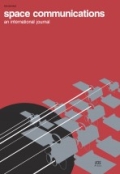Authors: Hsu, Eddie | Hung, Chaw | desJardins, Richard | Foster, Mark | Gilstrap, Ray | Chao, Larry | Gill, Mike | Tatsumi, Haruyuki | Edelson, Burt | Helm, Neil | Rae, Al Mac | Kadowaki, Naoto | Yoshimura, Naoko | Takahashi, Takashi | Gary, Pat | Lang, Paul | Kranacs, Kevin | Shopbell, Patrick | Walker, Gretchen | Wellnitz, Dennis | Gargione, Frank
Article Type:
Research Article
Abstract:
In 1993, a proposal at the Japan‐US Science, Technology, and Space Applications Program (JUSTSAP) workshop led to a subsequent series of satellite communications experiments and demonstrations, under the title of Trans‐Pacific High Data Rate Satellite Communications Experiments. The first phase of which was a joint collaboration between government and industry teams in the United States and Japan that successfully demonstrated distributed high definition video (HDV) post‐production on a global scale using a combination of high data rate satellites and terrestrial fiber optic asynchronous transfer mode (ATM) networks. This was followed by the Phase‐2 Internet Protocol (IP) based experiments and demonstrations
…[4–6] in tele‐medicine and distance education, using another combination of two high data rate satellites and terrestrial fiber optic networks. The Visible Human tele‐medicine and Remote Astronomy distance education demonstrations and their use of distributed systems technologies afforded an opportunity for people around the world to work together as a virtual team under one roof, using resources thousands of miles away as if they were next to each other. The visible human activity demonstrated global‐scale interactive biomedical image segmentation, labeling, classification, and indexing using large images; the remote astronomy activity demonstrated collaborative observation and distance education at multiple locations around the globe and the transparent operations of distributed systems technologies over a combination of broadband satellites and terrestrial networks. The use of Internet Protocol related technologies allowed the general public to be an integral part of the exciting activities, helped to examine issues in constructing a global information infrastructure with broadband satellites, and afforded an opportunity to tap the research results from the (reliable) multicast and distributed systems communities. This paper summarizes the Phase‐2 of Trans‐Pacific series of experiments and demonstrations by an international team in Canada, Japan, and the United States.
Show more
Citation: Space Communications,
vol. 18, no. 1-2, pp. 23-30, 2002
Price: EUR 27.50





